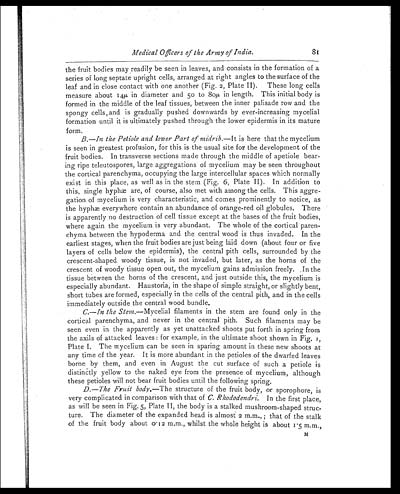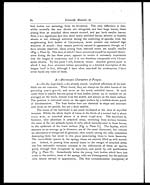Medicine - Institutions > Army health reports and medical documents > Scientific memoirs by medical officers of the Army of India > Part V, 1890 > 5 - On a Chrysomyxa on Rhododendron arboreum, Sm. (Chrysomyxa Himalense, Nov. Sp.)
(100) Page 81
Download files
Individual page:
Thumbnail gallery: Grid view | List view

Medical Officers of the Army of India.
81
the fruit bodies may readily be seen in leaves, and consists in the formation of a
series of long septate upright cells, arranged at right angles to the surface of the
leaf and in close contact with one another (Fig. 2, Plate II), These long cells
measure about 14µ in diameter and 50 to 80µ in length. This initial body is
formed in the middle of the leaf tissues, between the inner palisade row and the
spongy cells, and is gradually pushed downwards by ever-increasing mycelial
formation until it is ultimately pushed through the lower epidermis in its mature
form.
B.—In the Petiole and lower Part of midrib. —It is here that the mycelium
is seen in greatest profusion, for this is the usual site for the development of the
fruit bodies. In transverse sections made through the middle of apetiole bear-
ing ripe teleutospores, large aggregations of mycelium may be seen throughout
the cortical parenchyma, occupying the large intercellular spaces which normally
exist in this place, as well as in the stem (Fig. 6, Plate II). In addition to
this, single hyphæ are, of course, also met with among the cells. This aggre-
gation of mycelium is very characteristic, and comes prominently to notice, as
the hyphæ everywhere contain an abundance of orange-red oil globules. There
is apparently no destruction of cell tissue except at the bases of the fruit bodies,
where again the mycelium is very abundant. The whole of the cortical paren-
chyma between the hypoderma and the central wood is thus invaded. In the
earliest stages, when the fruit bodies are just being laid down (about four or five
layers of cells below the epidermis), the central pith cells, surrounded by the
crescent-shaped woody tissue, is not invaded, but later, as the horns of the
crescent of woody tissue open out, the mycelium gains admission freely. In the
tissue between the horns of the crescent, and just outside this, the mycelium is
especially abundant. Haustoria, in the shape of simple straight, or slightly bent,
short tubes are formed, especially in the cells of the central pith, and in the cells
immediately outside the central wood bundle.
C.—In the Stem. —Mycelial filaments in the stem are found only in the
cortical parenchyma, and never in the central pith. Such filaments may be
seen even in the apparently as yet unattacked shoots put forth in spring from
the axils of attacked leaves: for example, in the ultimate shoot shown in Fig. 1,
Plate I. The mycelium can be seen in sparing amount in these new shoots at
any time of the year. It is more abundant in the petioles of the dwarfed leaves
borne by them, and even in August the cut surface of such a petiole is
distinctly yellow to the naked eye from the presence of mycelium, although
these petioles will not bear fruit bodies until the following spring.
D.—The Fruit body. —The structure of the fruit body, or sporophore, is
very complicated in comparison with that of C. Rhododendri. In the first place,
as will be seen in Fig. 5, Plate II, the body is a stalked mushroom-shaped struc-
ture. The diameter of the expanded head is almost 2 m.m.,; that of the stalk
of the fruit body about 0.12 m.m., whilst the whole height is about 1.5 m.m.,
M
Set display mode to: Large image | Zoom image | Transcription
Images and transcriptions on this page, including medium image downloads, may be used under the Creative Commons Attribution 4.0 International Licence unless otherwise stated. ![]()
| Permanent URL | https://digital.nls.uk/75000548 |
|---|
| Shelfmark | IP/QB.10 |
|---|---|
| Additional NLS resources: | |




